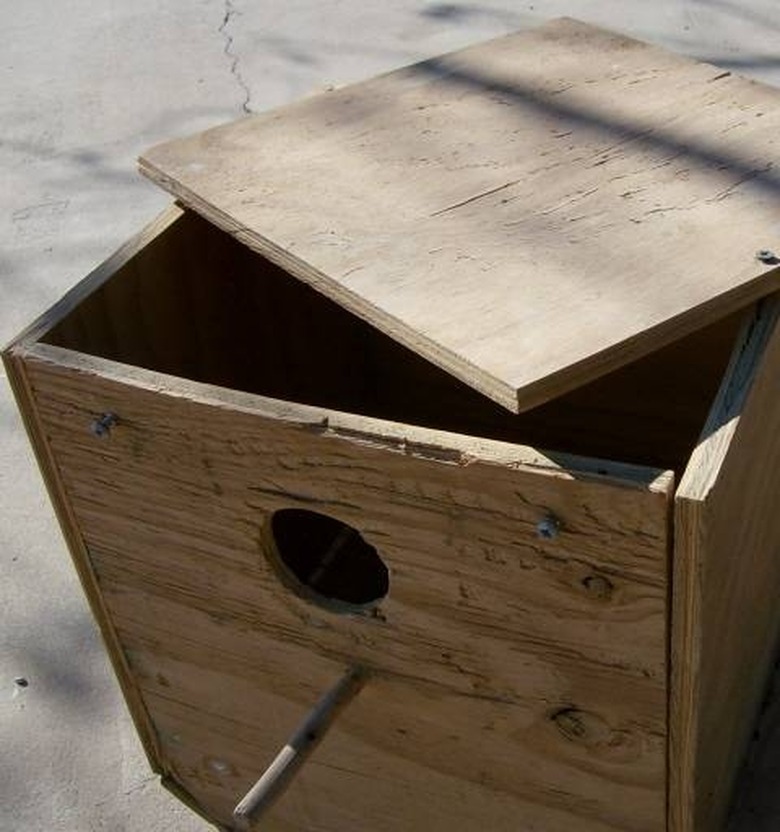How To Build A Nest Box For Macaws
Macaws are larger birds that won't fit into the typical small birdhouses seen in many backyards that are available for purchase at pet stores. You'll need to make your macaw breeding box a bit larger for these birds, but the process of building it will be similar to building any other birdhouse. You can build a bird cage using DIY wire panels, but it will need a solid floor for the nest. Using a few common materials and tools you might already have in your garage, you can build the perfect macaw breeding box for your birds.
Choose a location for the macaw nesting box
Choose a location for the macaw nesting box
Macaw hatchlings can stay in the nest for three to seven months. Before you begin building your macaw mansion, decide where you'll put it. This might help you decide if you want to place it on a pole or attach it to the house, if you want to make a gable roof or a shed roof, and which way it will face based on the elements.
Think about predators and neighborhood kids and how accessible you want the box to be. Putting the box on a metal pole and keeping the pole greased will prevent most critters from crawling up and getting into the birdhouse. Check the direction of the sun and wind to help you decide which way you want it to face.
Determine your dimensions
Determine
your dimensions
A macaw nesting box will need to house two birds, so macaw nest box dimensions should be at least 3 feet wide and 2 feet deep with a height of 2 feet. The entryway should be a circular hole about 8 inches around. Depending on the materials you have, you can play with these figures a bit, but it's better that the box is slightly larger than slightly smaller to make it comfortable for the birds to get in and out and move around once inside.
Gather the materials
Gather the materials
Buy or find the wood for the house, choosing pieces that are 1/2 inch to 3/4 inch thick. Macaws like to peck and chew, so avoid cheap pressboard that they can easily tear apart. Sand the wood to help the birds avoid splinters. Using screws makes your walls, floor, and roof attach more securely. Using nails is quicker, but the walls come apart easier if you'll be moving the box, and the pounding can split the wood.
Start the floor and walls
Start
the floor and walls
Use screws or nails to attach the back of your floorboard to the back wall of the house. Set the floorboard about 1/2 inch up on the back wallboard. Screw or nail the two side walls to the floorboard. Attach the front wall of the house (which has the hole for entry). Screw or nail the four wallboards to each other. The back wall should be about 1 inch higher than the front wall if you are building a shed roof that leans forward. Reverse this if you want the roof to angle backward.
To cut an 8-inch round hole in the front piece of wood, you'll need a special hole drill bit. Ask friends and neighbors if they have one you can borrow or if they'll drill the hole for you. You can glue or drill a small hole for a small piece of wood the birds can use as a perch just below the entry hole to help the birds enter and exit easier.
Types of roofs
Types of roofs
You can create a flat roof; a gable roof, which looks like an upside-down "V"; or a shed roof, which is one piece of wood that is higher on one side of the box than the other. Both gable and shed roofs let water drain off the roof. If you make a gable roof, be sure to put a metal or rubber strip or silicon on top of the line where the two pieces of wood meet to prevent water leakage into the box.
To make a shed roof, cut either the front or back walls about an inch higher than the other so the roof slants. You will need to cut the two side walls on an angle so you don't have a large gap between them and one part of the roof. It's a good idea to leave a small gap on each side to provide air circulation in the nest box.
To make a gable roof, angle the two pieces of roof wood together to make an upside-down "V" and screw or nail them together. Screw the lower portions of each piece of wood to the side walls. Cover the seam where the two pieces of wood meet at the top to prevent water leakage into the box.
Attaching the roof
Attaching the roof
You can attach the roof to the walls using hinges, which will help you get in and clean the box or easily remove the birds. Make sure to add a latching device to prevent predators from lifting the lid. Remember to remove nests before each mating season, as empty nests attract mites that can overwhelm and kill hatchlings next season.

